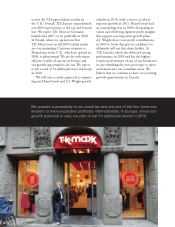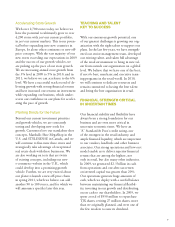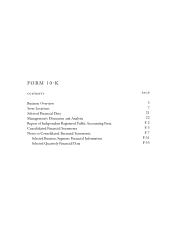TJ Maxx 2009 Annual Report Download - page 20
Download and view the complete annual report
Please find page 20 of the 2009 TJ Maxx annual report below. You can navigate through the pages in the report by either clicking on the pages listed below, or by using the keyword search tool below to find specific information within the annual report.well as Germany, where it expanded in 2007, and Poland, where it expanded in 2009. T.K. Maxx offers a
merchandise mix and targets customers similar to T.J. Maxx and Marshalls in the U.S. and Winners in Canada.
—HOMESENSE: HomeSense introduced the home fashions off-price concept to the U.K. in 2008 and its 14
stores offer a merchandise mix of home fashions in the U.K. like that of HomeGoods in the U.S. and
HomeSense in Canada. HomeSense primarily targets customers similar to those of HomeGoods in the U.S. and
HomeSense in Canada.
Flexible Business Model: Our off-price business model is flexible, particularly for a company of our size, allowing us
to react to market trends. Our opportunistic buying and inventory management strategies give us flexibility to adjust our
assortments more frequently than traditional retailers, and our stores and distribution centers are built and designed to
support this flexibility. By maintaining a liquid inventory position, our merchants can buy close to need, enabling them
to buy into current market trends and to take advantage of opportunities in the marketplace. Buying close to need gives
us the ability to turn our inventory more rapidly and adjust our pricing to the current market more frequently than
conventional retailers. Our selling floor space is flexible, without walls between departments and largely free of
permanent fixtures, so we can easily expand and contract departments in response to customer demand, available
merchandise and fashion trends. Our distribution facilities are designed to accommodate our methods of receiving and
shipping both small and large quantities of product to our large store base quickly and efficiently.
Opportunistic Buying: We are differentiated from traditional retailers by our opportunistic buying of quality, brand
name merchandise. We purchase the majority of our apparel inventory and a significant portion of our home fashion
inventory opportunistically and purchase virtually all of our inventory at discounts from initial wholesale prices. Our
merchant organization numbers over 700, and we operate 12 buying offices in the U.S. and abroad. We continue to
open many new vendors each year, sourcing from a vendor universe of over 12,000 in fiscal 2010. In contrast to
traditional retailers, which typically order goods far in advance of the time the product appears on the selling floor, our
merchants are in the marketplace virtually every week, buying primarily for the current selling season, and to a limited
extent, for a future selling season.
We have not experienced difficulty in obtaining adequate amounts of quality inventory for our business in either
favorable or difficult retail environments and believe that we will continue to have adequate inventory as we continue to
grow. Buying later in the inventory cycle than traditional retailers and maintaining flexibility in adapting to changing
conditions, we are able to take advantage of opportunities to acquire merchandise at substantial discounts, such as order
cancellations and manufacturer overruns, which regularly arise from the routine flow of inventory in the highly
fragmented apparel and home fashions marketplace. As a result, we are able to buy the vast majority of our inventory
opportunistically and directly from manufacturers, with some coming from retailers and other sources. A small
percentage of the merchandise we sell is private label merchandise produced specifically for us by third party
manufacturers.
We believe a number of factors make us an attractive outlet for the vendor community and provide us excellent
access on an ongoing basis to leading branded merchandise. We are willing to purchase less-than-full assortments of
items, styles and sizes, pay promptly and do not ask for typical retail concessions (such as advertising, promotional and
markdown allowances), delivery concessions(suchasdropshipmentstostoresordelayeddeliveries)orreturnprivileges.
Weareabletopurchasequantitiesofinventorythatrangefromsmalltoverylarge,andwehavetheabilitytosellproduct
through a geographically diverse network of stores. Importantly, in TJX, we offer vendors an outlet with financial
strength and an excellent credit rating.
Inventory Management: We offer our customers a rapidly changing selection of merchandise to create a “treasure
hunt” experience in our stores. To achieve this, we seek to rapidly turn the inventory in our stores, regularly offering fresh
selections of apparel and home fashions at excellent values. Our specialized inventory planning, purchasing, monitoring
and markdown systems, coupled with distribution center storage, processing, handling and shipping systems, enable us
to tailor the merchandise in our stores to local preferences, achieve rapid in-store inventory turnover on a vast array of
products and sell substantially all merchandise within targeted selling periods. We make pricing and markdown decisions
and store inventory replenishment determinations centrally, using information provided by specialized computer
4
























